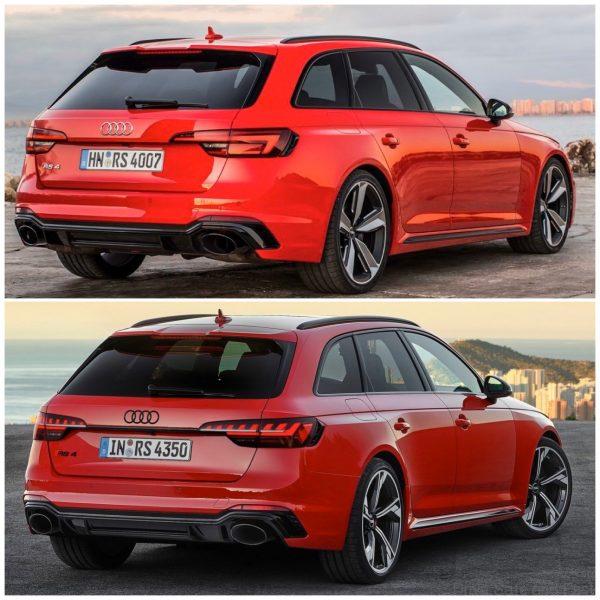Feels like it was just yesterday when Audi Sport GmbH showed off their 2018 model year Audi RS4 Avant. Well, now we’re getting the updated 2020 model which looks more like the recently announced RS6 Avant model.

There are, of course, many little differences between the original B9-generation RS4 Avant and this update. Chief among them:
- Newly designed front section
- Wider and flatter ‘Frameless’ Singleframe grille
- 3D honeycomb structure in gloss black
- sportier interior
- new MMI touch operating system
- RS4 emblem inserted directly into bumper
- large lateral air inlets and vertical flaps on bumper
- Redesigned LED headlights and darkened bezels for Optional matrix LED headlights
Here’s a visual comparison between this model and the pre-facelift:







Being an Audi, this new model’s interior is really where a lot of attention was paid. Here’s an excerpt from the press release that ought to give you an idea of the advances made.
PRESS RELEASE
Connected cockpit: the interior
The Audi RS 4 Avant (combined fuel consumption in l/100 km: 9,2 (25.6 US mpg); combined CO2 emissions in g/km: 211-210 (339.6-338 g/mi)) features a black interior. LED light guides trace the contours of the doors and the center console—doing so in up to 30 different colors in combination with the optional ambient lighting package. The horizontal alignment of the instrument panel creates a sense of spaciousness. The driver and front passenger are welcomed by the illuminated door sill trims that bear the RS 4 logo. Upon request, the RS design package adds some color to the interior, with the RS logo featured on the center console, the armrests, seat belts and floor mats. The steering wheel, selector lever and knee pads are all covered with Alcantara with red contrasting stitching. In addition to the red, the extended RS design package now also offers accents in gray. As a new highlight for the RS design package in red, the seat brackets in the backrest are also available in the matching color.
The 10.1-inch MMI touch display is the control center of the new operating system. It is located in the center of the instrument panel and tilted slightly toward the driver. The touch-sensitive screen displays a high-resolution graphic animation of an RS 4 Avant to welcome the driver. The MMI touch display provides acoustic feedback and takes over the functions of the previous rotary pushbutton on the center console. The driver can use the RS monitor to call up an overview of drive system component temperatures, maximum g-forces and information regarding tire pressures and temperatures. In the Audi virtual cockpit, special RS displays provide information on tire pressure, torque, power output, engine oil temperature, lap timings, acceleration measurements and g-forces. The shift light display prompts the driver to upshift when the rev limit is reached. The optional head-up display also providers some RS-specific information, for example the shift light display.
With its strict hierarchies, the menu structure of the new operating system is tailored to the user’s expectations and aims for easy operation. The natural language control also understands many phrases used in everyday language and quickly translates them into commands. The navigation in the new RS 4 Avant is now even more versatile and user-friendly. Audi connect and Audi connect plus provide a host of online services, such as Car-to-X services, which take advantage of the swarm intelligence of the Audi fleet.
The driver can actuate the two RS1 and RS2 modes in Audi drive select directly via a new “RS MODE” button on the flat-bottomed RS multifunction sport leather steering wheel. This automatically opens the RS-specific displays in the Audi virtual cockpit. The new aluminum shift paddles are considerably larger than before. Aside from the steering wheel and the illuminated door sill trims, the RS sport seats with optional honeycomb pattern and the shift gate also bear the RS emblem.